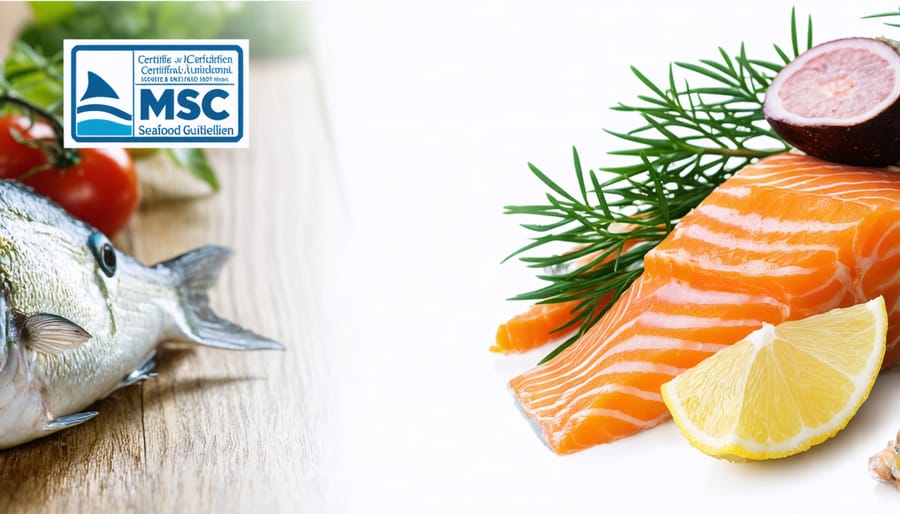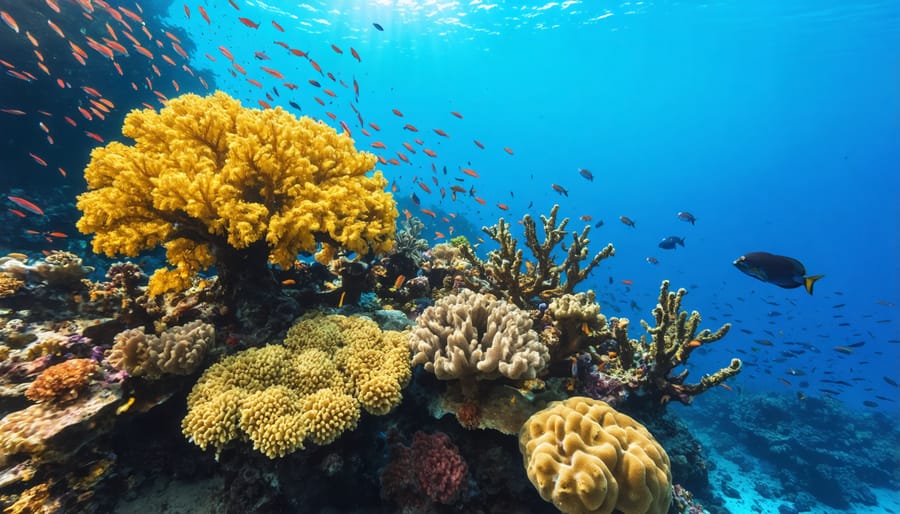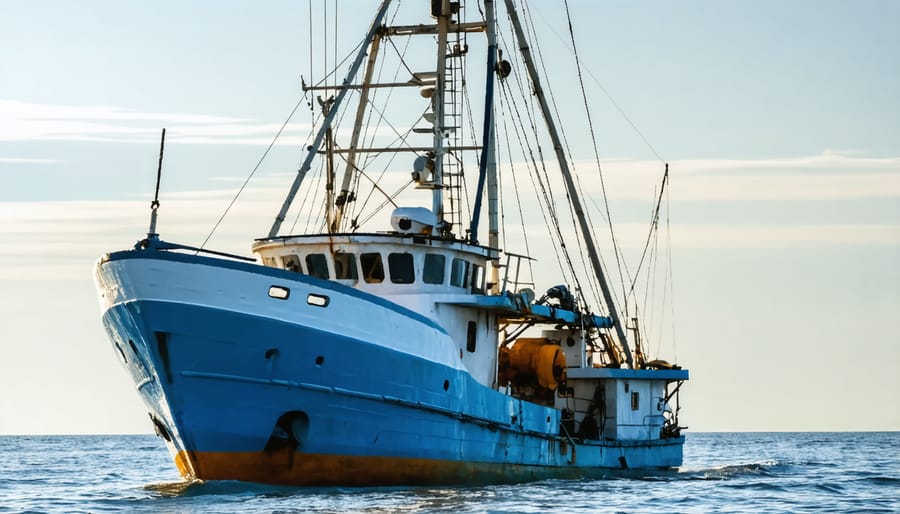
Certified sustainable seafood represents a crucial turning point in our efforts to protect marine wildlife while maintaining the world’s seafood supply. This rigorous certification process, overseen by organizations like the Marine Stewardship Council (MSC) and Aquaculture Stewardship Council (ASC), ensures fish populations remain healthy, fishing methods minimize ecosystem impact, and fisheries operate with effective management systems. As global seafood demand continues to rise, these certifications serve as a critical tool for consumers to make informed choices that support ocean health.
The certification process transforms how we harvest from our oceans, replacing destructive fishing practices with sustainable alternatives that consider both environmental impact and economic viability. For consumers, the blue MSC label or green ASC label represents a guarantee that their seafood choices actively contribute to ocean conservation. This system has already helped restore several fish populations while providing fishing communities with stable, long-term economic opportunities.
By choosing certified sustainable seafood, individuals become part of a larger movement that balances marine ecosystem protection with food security needs. This market-driven approach has proven remarkably effective at encouraging fishing industries worldwide to adopt more sustainable practices.
What Makes Seafood ‘Certified Sustainable’?
Major Certification Programs
Several prominent certification programs work to ensure sustainable seafood practices worldwide. The Marine Stewardship Council (MSC) leads the field, established in 1997 through a partnership between WWF and Unilever. MSC certification focuses on wild-capture fisheries, evaluating fish population health, environmental impact, and management effectiveness. Their blue fish label has become globally recognized, appearing on over 20,000 products in 100 countries.
The Aquaculture Stewardship Council (ASC) complements MSC by certifying farmed seafood. Founded in 2010, ASC certification requires strict environmental standards, responsible sourcing of feed, and fair labor practices. Their certification process involves regular audits and transparent reporting of farming practices.
Friend of the Sea (FOS) certifies both wild-caught and farmed seafood, along with aquarium fish and marine products. Their criteria include protection of target stocks, ecosystem impact minimization, and social accountability. FOS also uniquely addresses carbon footprint reduction in fishing operations.
Regional programs like Iceland Responsible Fisheries and Alaska Responsible Fisheries Management provide location-specific certification. These programs often maintain standards equivalent to international schemes while considering local ecosystem characteristics and traditional fishing practices.
Each certification program undergoes regular updates to reflect new scientific understanding and emerging conservation challenges. Independent third-party auditors verify compliance, ensuring transparency and credibility in the certification process.

The Certification Process
The certification process for sustainable seafood involves multiple rigorous steps and typically takes 12-18 months to complete. First, fisheries must undergo a pre-assessment to identify potential issues and determine their readiness for full evaluation. During this phase, independent certifiers review existing data about fish stocks, fishing methods, and environmental impacts.
If the pre-assessment is successful, the fishery enters the full assessment stage, where third-party certification bodies conduct detailed evaluations based on three core principles: sustainable fish populations, minimizing environmental impact, and effective fishery management. This involves extensive data collection, stakeholder interviews, and site visits to verify compliance.
The assessment team examines factors such as fishing gear selection, bycatch prevention measures, habitat protection strategies, and management systems. They also evaluate the fishery’s impact on the broader marine ecosystem and its ability to adapt to environmental changes.
Following the evaluation, assessors prepare a detailed report that undergoes peer review and public consultation. Stakeholders, including environmental organizations and industry experts, can provide feedback during this period. If the fishery meets all required standards, it receives certification, typically valid for five years.
However, the process doesn’t end there. Certified fisheries undergo annual surveillance audits to ensure continued compliance with sustainability standards. If improvements are needed, fisheries must develop and implement action plans to maintain their certification status.
Impact on Ocean Health
Preventing Overfishing
Sustainable seafood certification plays a crucial role in preventing overfishing by establishing strict protocols and monitoring systems that help maintain healthy fish populations. When fisheries seek certification, they must demonstrate their commitment to responsible fishing practices that ensure long-term species survival and ecosystem health.
These certification programs require fisheries to maintain detailed records of their catch volumes, fishing methods, and the status of target species populations. Independent auditors regularly assess these practices against scientific benchmarks, ensuring that harvest rates remain within sustainable limits. This systematic approach helps prevent the depletion of fish stocks, which is particularly important as climate change impacts on oceans continue to stress marine ecosystems.
Certified fisheries must also implement specific measures to reduce bycatch – the unintentional capture of non-target species. These measures include using selective fishing gear, avoiding critical breeding grounds, and establishing seasonal fishing restrictions. By protecting both target and non-target species, certification helps maintain the delicate balance of marine food webs.
Dr. Maria Santos, a marine biologist working with certification programs, explains: “When properly implemented, these standards create a positive feedback loop. As fish populations recover, fishing becomes more efficient and profitable, encouraging more fisheries to adopt sustainable practices.”
The certification process also requires regular population assessments and adjustments to fishing quotas based on scientific data. This adaptive management approach ensures that fishing activities can respond to changes in fish populations, helping prevent the collapse of fish stocks that has occurred in many unregulated fisheries.

Protecting Marine Habitats
Certified sustainable seafood practices play a crucial role in protecting marine ecosystems beyond individual species. When fishing operations adhere to certification standards, they actively contribute to the preservation of entire marine habitats, from coral reefs to seagrass meadows. These habitats serve as nurseries, feeding grounds, and shelter for countless marine species.
Sustainable fishing methods minimize physical damage to the seafloor and reduce the impact on sensitive marine environments. For example, certified fisheries often employ selective gear that prevents bottom trawling in vulnerable areas and maintains the structural integrity of underwater landscapes. This approach supports ongoing marine habitat restoration efforts while ensuring continued ecosystem functionality.
Marine biologist Dr. Sarah Chen explains, “When we protect habitats through sustainable fishing practices, we’re preserving entire communities of marine life. A single coral reef can support thousands of species, and maintaining its health is crucial for marine biodiversity.”
Certification programs require regular monitoring of habitat impacts, creating valuable data for conservation efforts. This information helps scientists track ecosystem health and adjust management strategies accordingly. Many certified fisheries also participate in habitat mapping initiatives, identifying and protecting essential fish habitats and migration corridors.
The ripple effects of habitat protection extend to coastal communities that depend on healthy marine ecosystems for their livelihoods. By maintaining habitat integrity, sustainable seafood certification helps ensure the long-term viability of fishing grounds while supporting the natural processes that make marine ecosystems resilient to environmental changes.
Success Stories from Certified Fisheries

From the Field
“Getting our fishery certified was one of the best decisions we’ve made,” says Sarah Martinez, a third-generation fishing operator from Maine. “Not only has it helped us secure better market access, but it’s given us pride knowing we’re protecting the ocean for future generations.”
Martinez’s story echoes across the industry. In Alaska, Tom Kirkpatrick’s salmon fishing operation earned MSC certification in 2019. “The certification process taught us to think differently about our impact. We’ve implemented better tracking systems and reduced our bycatch significantly. The whole crew feels more invested in the process.”
In Norway, Astrid Johannsen manages a certified cod fishery that’s been operating sustainably for over a decade. “The certification standards pushed us to innovate,” she explains. “We developed new net designs that minimize seabed impact and protect juvenile fish. Our catch rates are actually better now than before certification.”
Small-scale operators are joining the movement too. Carlos Mendoza, who runs a family fishing business in Peru, recently achieved certification: “It was challenging at first, but the long-term benefits are clear. We’re seeing healthier fish populations, and our customers appreciate knowing their seafood comes from a responsible source.”
These stories demonstrate how certification isn’t just about paperwork – it’s about transforming fishing practices and creating a sustainable future for our oceans.
Measurable Results
The implementation of sustainable seafood certification programs has yielded significant positive outcomes for marine ecosystems and fishing communities worldwide. Recent data from the Marine Stewardship Council (MSC) shows that certified fisheries have experienced a 94% reduction in bycatch over the past decade. Additionally, fisheries participating in certification programs have reported a 28% increase in target species populations since 2010.
Economic indicators also demonstrate the growing impact of certified sustainable seafood. The global market for certified sustainable seafood products reached $11.5 billion in 2022, marking a 35% increase from 2018. Participating fisheries have documented an average premium of 15% for their certified products, providing tangible economic benefits to fishing communities.
Studies conducted across multiple regions reveal that certified fisheries demonstrate superior compliance with environmental regulations, with monitoring data showing a 76% improvement in adherence to catch limits and seasonal restrictions. The number of certified fisheries worldwide has grown from 100 in 2010 to over 400 in 2023, representing approximately 17% of global wild-caught seafood.
Conservation success stories include the recovery of the Patagonian toothfish populations, which saw a 60% increase in biomass after certification, and the North Atlantic swordfish fishery, where sustainable practices led to a 50% reduction in juvenile catch rates. These measurable improvements demonstrate the tangible benefits of certification programs in promoting ocean health and sustainable fishing practices.
How Consumers Can Support Sustainable Seafood
Making sustainable seafood choices is easier than ever, with numerous tools and resources available to help consumers make informed decisions. One of the most effective ways to support ocean health is by checking for certification labels when purchasing seafood. The Marine Stewardship Council (MSC) blue fish label and the Aquaculture Stewardship Council (ASC) label are two widely recognized certifications that indicate sustainable fishing practices.
Download sustainable seafood guide apps to your smartphone for instant access to recommendations while shopping. These apps often include up-to-date information about species status, fishing methods, and alternative choices when your preferred option isn’t sustainable. Popular options include the Seafood Watch app and FishChoice, which provide region-specific recommendations.
When dining out, don’t hesitate to ask restaurants about the source of their seafood. Many establishments are proud to share information about their sustainable sourcing practices, and consumer inquiry encourages more businesses to adopt responsible conservation strategies.
Consider diversifying your seafood choices by trying less popular species. This helps reduce pressure on heavily fished populations while introducing you to delicious alternatives. For example, instead of tuna, try Arctic char or Pacific sardines, which are often more sustainable choices.
Support local fisheries that practice sustainable methods by purchasing from community-supported fishery programs (CSFs). These programs connect consumers directly with fishers who prioritize environmental stewardship and often provide fresher, seasonal catches.
Stay informed about seafood sustainability issues by subscribing to newsletters from marine conservation organizations. Many offer regular updates about sustainable fishing practices, success stories, and new certification developments. You can also participate in community events and workshops focused on sustainable seafood education.
Remember to reduce seafood waste by properly storing your purchases, using leftovers creatively, and planning meals thoughtfully. This not only maximizes your investment but also honors the resources used to harvest the seafood.
Certified sustainable seafood represents a crucial bridge between marine conservation and responsible consumption, offering hope for the future of our oceans. Through rigorous certification processes and ongoing monitoring, this system helps protect vulnerable marine species, supports fishing communities, and ensures the long-term viability of our seafood resources.
By choosing certified sustainable seafood, consumers become active participants in ocean conservation. Every purchase decision sends a clear message to the fishing industry and retailers about the importance of responsible fishing practices. This collective action has already led to meaningful changes, with many major fishing operations adopting more sustainable methods and retailers committing to sourcing certified products.
The future of our oceans depends on informed choices and continued commitment to sustainability. As consumers, we can make a difference by checking for certification labels, asking questions about seafood sourcing, and supporting businesses that prioritize sustainable practices. Educational institutions, restaurants, and food service providers can amplify this impact by making sustainable seafood a standard requirement in their purchasing policies.
Take action today: Look for certification labels when shopping, share knowledge about sustainable seafood with others, and consider supporting organizations that work towards ocean conservation. Together, we can ensure that future generations will continue to benefit from healthy, abundant oceans while protecting the delicate marine ecosystems that make it all possible.
jessica
Ava Singh is an environmental writer and marine sustainability advocate with a deep commitment to protecting the world's oceans and coastal communities. With a background in environmental policy and a passion for storytelling, Ava brings complex topics to life through clear, engaging content that educates and empowers readers. At the Marine Biodiversity & Sustainability Learning Center, Ava focuses on sharing impactful stories about community engagement, policy innovations, and conservation strategies. Her writing bridges the gap between science and the public, encouraging people to take part in preserving marine biodiversity. When she’s not writing, Ava collaborates with local initiatives to promote eco-conscious living and sustainable development, ensuring her work makes a difference both on the page and in the real world.
